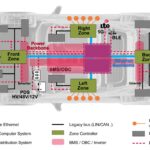 Intel has expanded its automotive product portfolio with integrated solutions for electric and software-defined vehicles (SDVs). The platform comprises high-performance compute units, discrete graphics, AI processing capabilities, power management systems, and zonal controller solutions, supported by the Intel® Automotive Virtual Development Environment (VDE) developed in conjunction with AWS.
Intel has expanded its automotive product portfolio with integrated solutions for electric and software-defined vehicles (SDVs). The platform comprises high-performance compute units, discrete graphics, AI processing capabilities, power management systems, and zonal controller solutions, supported by the Intel® Automotive Virtual Development Environment (VDE) developed in conjunction with AWS.
The Adaptive Control Unit (ACU) U310 features an integrated flexible logic area for real-time control algorithm offloading, enabling multi-workload consolidation with deterministic data delivery. The architecture implements Freedom from Interference (FFI) principles while consolidating microcontroller workloads in a single zonal MCU. The dual processing architecture combines CPU cores with a flexible logic area for enhanced performance distribution.
The system achieves powertrain system energy loss reduction of up to 40%, coupled with a 3-5% WLTP efficiency improvement. The unit provides adaptive high voltage and control frequency management, incorporating real-time driver style and road condition optimization for maximum efficiency.
Stellantis Motorsports has integrated the technology into their next-generation inverter control system, focusing on electric motor control and braking energy recovery within Formula E racing conditions. Karma Automotive has implemented an inverter featuring Optimal Pulse Pattern control, incorporating four distinct driving profiles along with Torque Ripple Reduction and Range Boost functionality.
Scheduled for production by the end of 2025, the second-generation Intel Arc™ B-series Graphics system supports advanced in-vehicle AI workload processing and next-generation HMI engine operations. The system maintains compatibility with AAA PC gaming while providing scalable AI task processing capabilities.
The development environment integrates with Intel Xeon® processor-based Amazon EC2 instances and provides native support for Intel Automotive SDV SoCs. The system maintains hardware-software parity between cloud and vehicle environments, enabling direct ECU development without simulation requirements.
The consolidated architecture integrates electronic control systems with real-time processing capabilities. The system adapts to various vehicle topologies while reducing electronic component requirements through standardized development protocols. This integration enables streamlined development processes across all vehicle systems and subsystems.


Leave a Reply